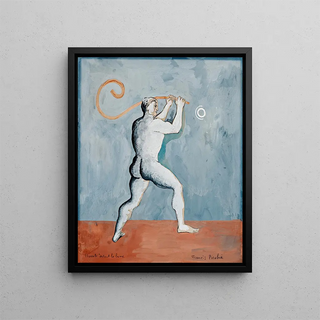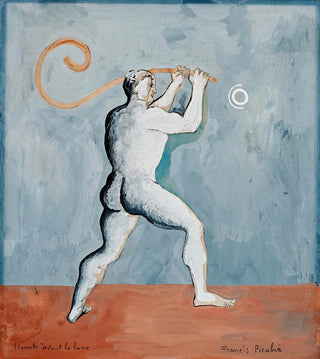Art print | Hercules before the moon - Francis Picabia


View from behind

Frame (optional)
In the fascinating world of modern art, the art print "Hercule devant la lune" by Francis Picabia stands out for its boldness and depth. This iconic piece, which evokes both mythology and modernity, invites viewers to reflect on the duality of man in relation to nature and his own demons. Immersing ourselves in this universe, we discover a painting that transcends mere visuals to become a true sensory experience. The depiction of Hercules, this mythological hero, confronting the majesty of the moon, challenges us and prompts us to question our place in a often chaotic world. The magic of this work lies in its ability to capture complex emotions while remaining accessible and engaging.
Style and uniqueness of the work
Francis Picabia's style is characterized by a daring fusion of various artistic movements, ranging from Dadaism to Cubism. In "Hercule devant la lune," this uniqueness manifests through a palette of vibrant colors and dynamic shapes that seem to dance across the canvas. The contrast between shadow and light emphasizes the dramatic tension of the scene, while fluid lines evoke a sense of movement and life. Picabia skillfully plays with perceptions, creating an atmosphere that is both dreamlike and realistic. The meticulous details, such as Hercules's facial expressions and the texture of the moon, testify to undeniable technical mastery. This work is not just a simple representation; it becomes a dialogue between the artist, the subject, and the viewer, making each gaze unique and personal.
The artist and his influence
Francis Picabia, an emblematic figure of modern art, managed to mark his era with his avant-garde vision and provocative spirit. Born in 1879 in Paris, he evolved within numerous artistic currents, appropriating and reinventing their codes. His artistic journey reflects an incessant quest for innovation and experimentation. Picabia surrounded himself with influential personalities, collaborating with artists such as Marcel Duchamp and Giorgio de Chirico, which

Matte finish

View from behind

Frame (optional)
In the fascinating world of modern art, the art print "Hercule devant la lune" by Francis Picabia stands out for its boldness and depth. This iconic piece, which evokes both mythology and modernity, invites viewers to reflect on the duality of man in relation to nature and his own demons. Immersing ourselves in this universe, we discover a painting that transcends mere visuals to become a true sensory experience. The depiction of Hercules, this mythological hero, confronting the majesty of the moon, challenges us and prompts us to question our place in a often chaotic world. The magic of this work lies in its ability to capture complex emotions while remaining accessible and engaging.
Style and uniqueness of the work
Francis Picabia's style is characterized by a daring fusion of various artistic movements, ranging from Dadaism to Cubism. In "Hercule devant la lune," this uniqueness manifests through a palette of vibrant colors and dynamic shapes that seem to dance across the canvas. The contrast between shadow and light emphasizes the dramatic tension of the scene, while fluid lines evoke a sense of movement and life. Picabia skillfully plays with perceptions, creating an atmosphere that is both dreamlike and realistic. The meticulous details, such as Hercules's facial expressions and the texture of the moon, testify to undeniable technical mastery. This work is not just a simple representation; it becomes a dialogue between the artist, the subject, and the viewer, making each gaze unique and personal.
The artist and his influence
Francis Picabia, an emblematic figure of modern art, managed to mark his era with his avant-garde vision and provocative spirit. Born in 1879 in Paris, he evolved within numerous artistic currents, appropriating and reinventing their codes. His artistic journey reflects an incessant quest for innovation and experimentation. Picabia surrounded himself with influential personalities, collaborating with artists such as Marcel Duchamp and Giorgio de Chirico, which






